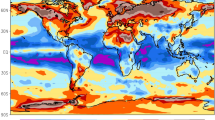Abstract.
Data sets of the changes of the length of day (ΔLOD) measured by space geodetic techniques and of the atmospheric angular momentum (AAM) derived from global meteorological data by the National Meteorological Center (NMC) and the National Centers for Environmental Prediction/National Center for Atmospheric Research (NCEP/NCAR) are used to reanalyze and study the excitations of ΔLOD, and to examine and compare the contribution of each AAM series to ΔLOD. The main results are as follows.
1. The AAM reanalyzed with the assimilated global meteorological data by NCEP/NCAR are more accurate and have lower noise than the original AAM derived by NMC. The NCEP/NCAR-based AAM is more consistent with the changes of the length-of-day series.
2. The NCEP reanalysed AAM data may better explain the non-tidal LOD variations on intraseasonal to interannual time scales, especially on the quasi-biennial time scale. The atmosphere cannot, however, explain all LOD variations; other excitation sources are possible.
3. The effects of atmosphere on the estimated values of tides for ΔLOD components up to a month are weak. The preliminary results of the annual and semiannual tides can be estimated after removing the effects of atmosphere from ΔLOD.
Similar content being viewed by others
Author information
Authors and Affiliations
Additional information
Received: 27 May 1998 / Accepted: 22 March 1999
Rights and permissions
About this article
Cite this article
Yu, N., Zheng, D. & Wu, H. Contribution of new AAM data source to δLOD excitation. Journal of Geodesy 73, 385–390 (1999). https://doi.org/10.1007/s001900050257
Issue Date:
DOI: https://doi.org/10.1007/s001900050257




